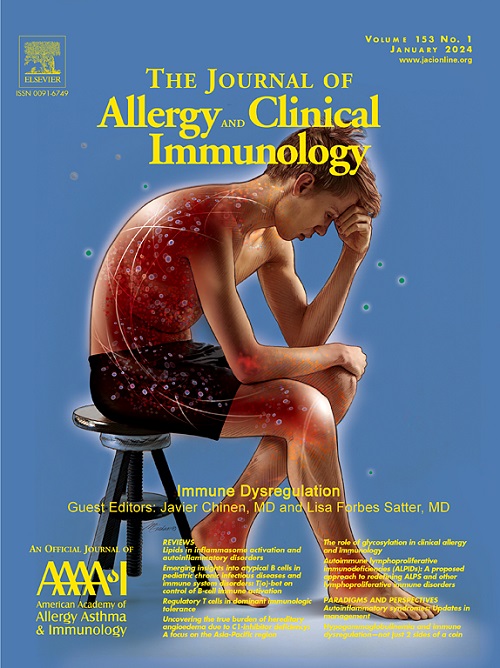儿童和青少年哮喘患者鼻结膜炎症状:纵向聚类分析
IF 11.4
1区 医学
Q1 ALLERGY
引用次数: 0
摘要
背景:鼻结膜炎的表型通常是根据症状严重程度、持续时间、季节性和气致过敏原致敏性来描述的。目前尚不清楚这些表型是否完全反映了在人群水平上看到的症状模式。目的:采用无偏倚的方法,根据症状强度和季节性确定鼻结膜炎的表型,并比较其特征。方法:对低收入城市环境哮喘患儿进行前瞻性随访,采用鼻结膜炎活动问卷,对患儿进行为期12个月的上、下气道疾病管理,每2个月进行一次标准化随访。我们确定了个体鼻结膜炎症状轨迹和这些轨迹的集群,并比较了聚焦于特应性特征的集群。结果:619例患儿共出现5类症状,其中2例为重度症状(22.5%),但季节性不同,1例为中度症状(13.6%),1例为中度鼻塞(20.4%),1例为轻度症状(43.6%)。后者进一步分为两个亚组,如果经常使用鼻皮质类固醇(23.6%)或不使用(20.0%)。低症状群无季节变化。在高症状群中,过敏致敏的数量和过敏性气道疾病的家族史较高,但过敏致敏不能解释季节性差异。结论:本研究确定了以前未报道过的鼻结膜炎表型,并且没有通过人口统计学或特应性和2型炎症的测量来区分。为了更好地了解鼻结膜炎的病理生物学,需要研究过敏以外的因素。本文章由计算机程序翻译,如有差异,请以英文原文为准。
Rhinoconjunctivitis symptoms in children and adolescents with asthma: Longitudinal clustering analysis
Background
Rhinoconjunctivitis phenotypes are conventionally described on the basis of symptom severity, duration and seasonality, and aeroallergen sensitization. It is not known whether these phenotypes fully reflect the patterns of symptoms seen at a population level.
Objective
We sought to identify phenotypes of rhinoconjunctivitis on the basis of symptom intensity and seasonality using an unbiased approach and to compare their characteristics.
Methods
A cohort of children with asthma in low-income urban environments was prospectively followed with a rhinoconjunctivitis activity questionnaire, and their upper and lower airway disease was managed for 12 months with every 2-month visit based on standardized algorithms. We identified individual rhinoconjunctivitis symptom trajectories and clusters of those trajectories and compared the clusters focusing on atopic characteristics.
Results
Data obtained from 619 children yielded 5 symptom clusters: 2 had high symptoms (22.5%) but differed in seasonal pattern, 1 had medium symptoms (13.6%), 1 had medium nasal congestion only (20.4%), and 1 had low symptoms (43.6%). The latter was further split into 2 subgroups if nasal corticosteroids were frequently prescribed (23.6%) or not (20.0%). Seasonal variation was absent in the low symptom clusters. The number of allergic sensitizations and family history of allergic airway disease were higher in the high symptom clusters, but allergic sensitization did not explain differences in seasonality.
Conclusions
This study identified rhinoconjunctivitis phenotypes that have not been previously reported and were not differentiated by demographics or by measures of atopy and type 2 inflammation. Factors beyond allergy need to be investigated to better understand the pathobiology of rhinoconjunctivitis.
求助全文
通过发布文献求助,成功后即可免费获取论文全文。
去求助
来源期刊
CiteScore
25.90
自引率
7.70%
发文量
1302
审稿时长
38 days
期刊介绍:
The Journal of Allergy and Clinical Immunology is a prestigious publication that features groundbreaking research in the fields of Allergy, Asthma, and Immunology. This influential journal publishes high-impact research papers that explore various topics, including asthma, food allergy, allergic rhinitis, atopic dermatitis, primary immune deficiencies, occupational and environmental allergy, and other allergic and immunologic diseases. The articles not only report on clinical trials and mechanistic studies but also provide insights into novel therapies, underlying mechanisms, and important discoveries that contribute to our understanding of these diseases. By sharing this valuable information, the journal aims to enhance the diagnosis and management of patients in the future.

 求助内容:
求助内容: 应助结果提醒方式:
应助结果提醒方式:


